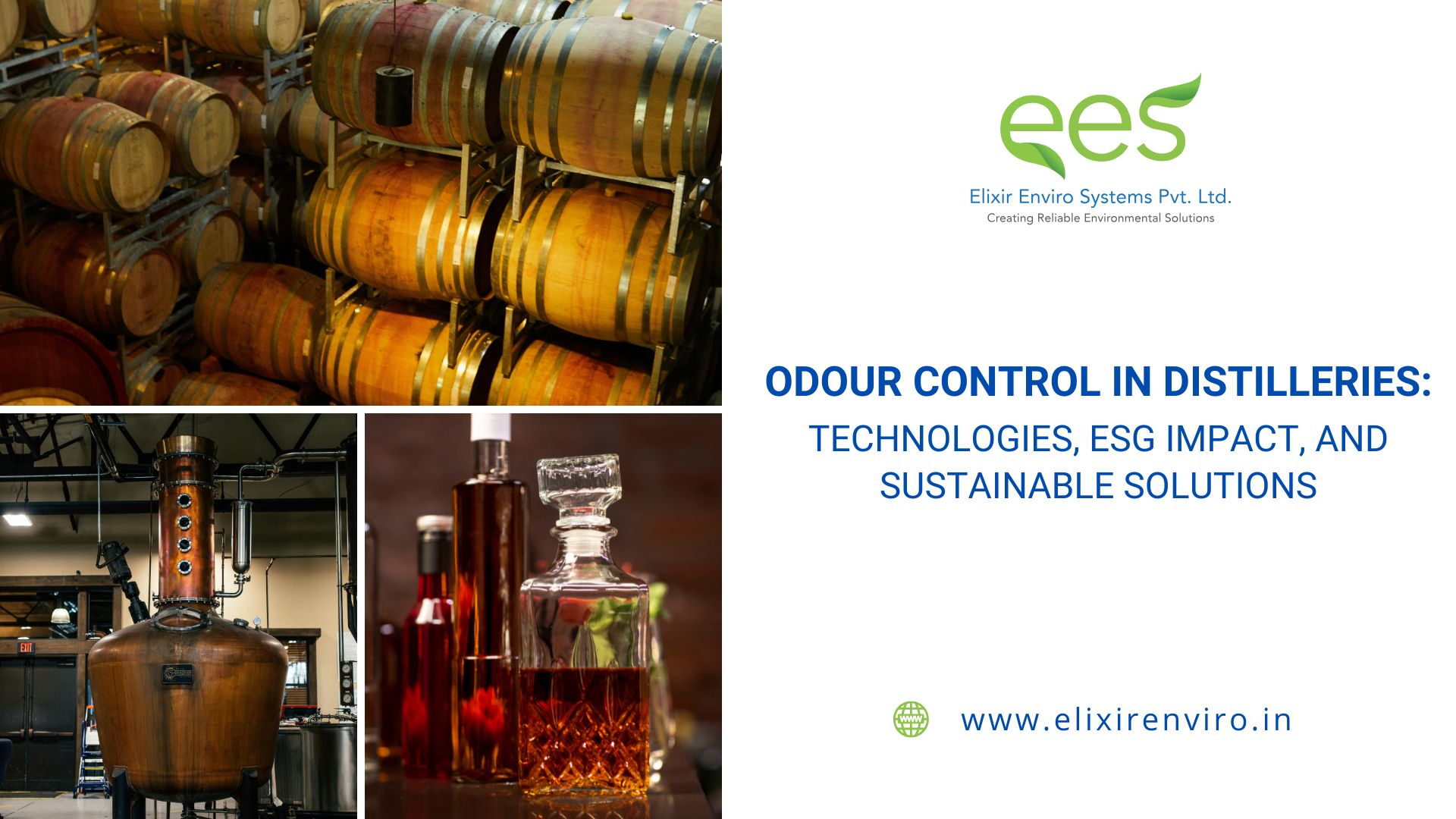
Distilleries are important to India’s beverage and ethanol industries. They produce everything from high-quality spirits to the fuel-grade ethanol used in the country’s bioethanol blending program. These operations promote economic growth, support renewable energy, and provide crucial help to rural communities. However, there is a challenge that worries both local communities and regulators. It involves the strong odours that often come from distillery operations.
Fermentation processes spent wash handling, storage, and effluent treatment plants release strong, unpleasant smells that can travel far beyond the factory walls. These odours not only affect worker comfort and community health but also attract regulatory complaints and damage brand reputation. Despite their seriousness, odour issues are often overlooked in favour of more visible measures like wastewater treatment or Zero Liquid Discharge (ZLD).
This is something that Elixir Enviro Systems can provide a difference—assisting distilleries deal with odour issues through sustainable, efficient outcomes.
In this blog, we’ll explore:
By the end, you’ll see why odour control is not just a regulatory requirement but a strategic investment—and how Elixir Enviro Systems can help distilleries turn this challenge into a sustainable advantage.
The characteristic smells from distilleries mainly come from the breakdown of organic matter, fermentation processes, and chemical reactions that happen during alcohol production. How strong and long-lasting these odours are often depends on the type of raw materials used, how by-products are handled, and the management of waste streams like spent wash.
Several compounds are responsible for the characteristic “distillery smell”:
Compared to grain-based plants, molasses-based distilleries are typically far more odour-intensive. One cause is being the handling of by products and wastewater, and is mainly due to:
While grain-based distilleries also emit odours, their effluents are easier to treat, making emissions comparatively less intense.
Odour generation occurs at multiple points in the production process. Key sources include:
1 Fermentation Tanks
Fermentation releases carbon dioxide mixed with ethanol vapours, aldehydes, and fusel oils, producing noticeable solvent-like odours around tanks.
2 Distillation Units
Distillation strips VOCs and fusel oils from the process stream. If gases from condensers and vents are not captured, they lead to strong odour emissions.
3 Spent Wash Lagoons
The single biggest source of odour in distilleries. Anaerobic decomposition of spent wash continuously releases foul gases such as hydrogen sulphide and volatile fatty acids.
4 Sludge Drying and Handling
Sludge rich in organics emits hydrogen sulphide, ammonia, and amines during drying, storage, or handling. Without proper management, this becomes a persistent odour source.
5 By-Products and Residues
By-products like press mud, compost, and distillers dried grains with solubles (DDGS) can produce strong odours if not stored properly. This adds to the overall odour issue.
Odour management is no longer just an environmental best practice—it is increasingly linked to regulatory compliance and social acceptance. Both Indian and global frameworks are tightening their expectations for distilleries to actively control odour emissions.
Across the world, environmental regulators are moving beyond traditional emission-based limits and focusing more on how industrial operations affect surrounding communities. For distilleries, this means that simply meeting emission standards may no longer be enough. If odour complaints persist, authorities can still impose penalties, restrict operations, or require the adoption of advanced odour control technologies.
Effective odour management depends on measuring and tracking emissions. Distilleries are adopting both traditional and advanced monitoring tools to ensure transparency and compliance.
Distilleries worldwide have implemented innovative odour control strategies that Indian plants can adapt to remain competitive and sustainable:
For Indian distilleries, adopting these proven practices can not only resolve local odour issues but also align operations with global sustainability benchmarks.
Managing odour in distilleries requires a combination of technologies and operational best practices. No single solution works in isolation; instead, a carefully designed system ensures compliance, efficiency, and community acceptance.
The most effective odour management plan is multi-pronged—combining biological, chemical, process-level, and monitoring solutions tailored to site-specific needs.
Odour management is more than just an operational requirement—it’s an important part of a distillery’s Environmental, Social, and Governance (ESG) performance. By investing in advanced odour control technologies, distilleries show their commitment to sustainability, transparency, and creating long-term value for both the business and the communities around them.
By implementing advanced odour control systems, distilleries can improve their ESG ratings, making themselves more attractive to investors, global partners, and eco-conscious consumers.
At Elixir Enviro Systems (EES), we specialise in delivering end-to-end odour control solutions for distilleries, combining technical innovation with sustainability. Our approach is tailored to each facility, ensuring compliance, efficiency, and long-term reliability.
Our expertise includes:
With over a million m³/hr air treatment capacity delivered across industries, Elixir helps distilleries not just manage odour but turn it into an opportunity for sustainability, community acceptance, and ESG leadership.
Odour control in distilleries goes far beyond regulatory compliance — it reflects a sense of responsibility, sustainability, and long-term competitiveness. When odours from fermentation, distillation, and spent wash lagoons are left unchecked, they can weaken community trust, invite regulatory action, and harm a distillery’s reputation.
By adopting modern technologies such as anaerobic digestion, biofiltration, scrubbing systems, and Zero Liquid Discharge (ZLD), distilleries can turn odour management from an operational burden into a strategic opportunity — improving environmental performance while building stronger relationships with the communities they serve.
Through an ESG perspective, odour control delivers triple benefits:
Distilleries that prioritise odour management today will not only stay ahead of tightening regulations but also build stronger market positions, healthier communities, and greater investor confidence—emerging as truly future-ready businesses.
Q1. Why do distilleries produce such strong odours?
Distilleries generate strong odours mainly due to the breakdown of organic materials during processes like fermentation, distillation, and effluent treatment. Gases such as hydrogen sulphide (H₂S), volatile fatty acids (VFAs), and volatile organic compounds (VOCs) are the key culprits behind these unpleasant smells.
Q2. What is the biggest source of odour in distilleries?
The single largest source is spent wash lagoons, where untreated effluent decomposes anaerobically, releasing foul-smelling gases such as H₂S, ammonia, and VFAs
Q3. How can distilleries effectively control odours?
A multi-pronged approach works best—combining biological systems (biofilters, biotrickling filters), chemical/physical systems (scrubbers, activated carbon), and process optimisation (anaerobic digestion, covered lagoons).
Q4. What are the regulatory requirements for odour control in Indian distilleries?
The CPCB mandates Zero Liquid Discharge (ZLD) for molasses-based distilleries. In addition, State Pollution Control Boards (SPCBs) can act on community complaints, sometimes halting operations until corrective measures are taken.
Q5. How does odour control improve ESG performance?
Odour management reduces harmful emissions (Environmental), protects workers and nearby communities (Social), and ensures transparent compliance with norms (Governance)—boosting overall ESG ratings




